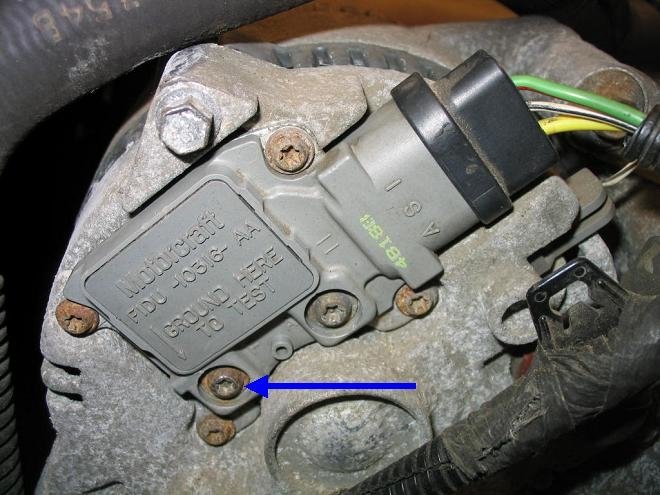This photo is from a Tempo, but your regulator should look the same. The blue arrow is pointing to the screw head that needs to be grounded with a clip lead or any piece of wire. You'll note that this one is rather rusty, so it would be necessary to scratch at it a little to make a good momentary connection. Same with the surface corrosion on the generator's housing.
If this works, you'll suddenly hear the generator whine a little, and load the engine down as it starts charging. If you have the head lights on or you have a helper watching the voltmeter at the battery, you'll see system voltage start to rise. If this test indicates the regulator is defective, it can often be replaced without removing the generator from the engine, as is the case here with the Tempo. Remove the four screw in the four corners, not the one with the blue arrow or the other one across from it. These should be T15 or T20 Torx heads.
If you remove the "A" screw and the "F" screw, (blue arrow), the brush assembly will detach from the regulator. Doesn't matter as a new regulator comes with a new set of brushes already bolted on and ready to install. Notice too the small hole between the "A" and "F" screws. There will be a small wooden stick, like a toothpick, in there. That's to hold the brushes retracted so they'll slip over the slip rings without being cracked or damaged. Once the regulator is bolted on, slide that stick out and you'll hear the spring-loaded brushes snap into place.
I'm betting there will be no change when you ground the "F" terminal. That would point to some defect within the generator. The best suspect I can think of is the output stud's connection has burned off just inside the housing. That would leave the circuit intact that is monitored by the regulator to know when the system is working, and 12 volts would still show up on the smaller red wire from the battery to keep the regulator working. The only other defect I can think of would be multiple failed diodes. With some physical designs, especially on older Chrysler products, a shorted diode would overheat, then burn off one of its connections, so it would no longer pose a potential dead short if a second diode were to short. In that way, there could be as many as three or four defective diodes that would cause no or low charge, but no blown fuses.
There's one more thing to peek at. Your generator should be bolted solidly to the metal mounting bracket. If it is, this doesn't apply. On a few models, generators are mounted on rubber bushings to isolate them from engine vibration. As such, they have to use a separate bolted-on ground cable between the generator's housing and any point on the engine. That cable or braided strap can corrode off resulting in a no-charge condition. The often-overlooked clue is if you measure voltage with the meter's ground probe on the engine block, you'll find 12 volts on the generator's housing.
Was this helpful?
Yes
No
+1
Tuesday, December 29th, 2020 AT 12:16 PM



